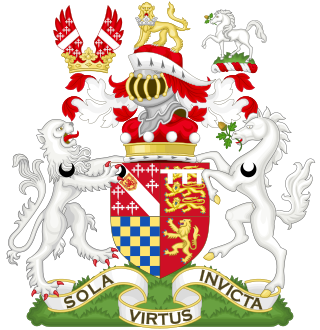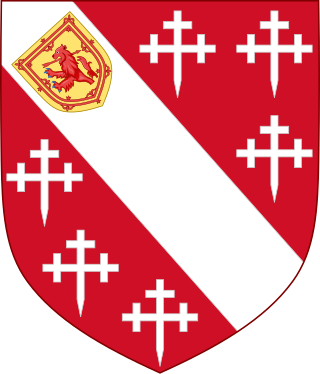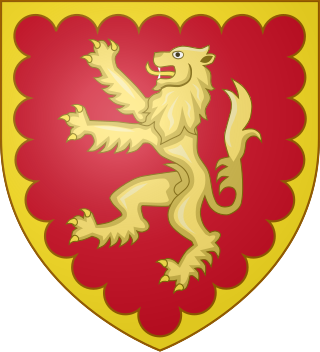
Duke of Norfolk is a title in the peerage of England, and is the premier non-royal peerage. The seat of the Duke of Norfolk is Arundel Castle in Sussex, although the title refers to the county of Norfolk. The current duke is Edward Fitzalan-Howard, 18th Duke of Norfolk. The dukes have historically been Catholic, a state of affairs known as recusancy in England.

Edmund Bernard FitzAlan-Howard, 1st Viscount FitzAlan of Derwent, known as The Honourable Edmund Fitzalan-Howard between 1855 and 1856, Lord Edmund Fitzalan-Howard between 1856 and 1876, and Lord Edmund Talbot between 1876 and 1921, was a British Conservative politician and the last Lord Lieutenant of Ireland. He was the first Roman Catholic to be appointed Lord Lieutenant of Ireland since the 17th century, holding office when Ireland was partitioned into Southern Ireland and Northern Ireland.

Duke of Grafton is a title in the Peerage of England. It was created in 1675 by Charles II of England for Henry FitzRoy, his second illegitimate son by the Duchess of Cleveland. The most notable duke of Grafton was Augustus FitzRoy, 3rd Duke of Grafton, who served as Prime Minister from 1768–1770.

Earl of Leicester is a title that has been created seven times. The first title was granted during the 12th century in the Peerage of England. The current title is in the Peerage of the United Kingdom and was created in 1837.

Earl of Shrewsbury is a hereditary title of nobility created twice in the Peerage of England. The second earldom dates to 1442. The holder of the Earldom of Shrewsbury also holds the title of Earl of Waterford (1446) in the Peerage of Ireland and Earl Talbot (1784) in the Peerage of Great Britain. Shrewsbury and Waterford are the oldest earldoms in their peerages held by someone with no higher title, and as such the Earl of Shrewsbury is sometimes described as the premier earl of England and Ireland.

Earl of Carlisle is a title that has been created three times in the Peerage of England.

Baron Stafford, referring to the town of Stafford, is a title that has been created several times in the Peerage of England. In the 14th century, the barons of the first creation were made earls. Those of the fifth creation, in the 17th century, became first viscounts and then earls. Since 1913, the title has been held by the Fitzherbert family.

Viscount Falmouth is a title that has been created twice, first in the Peerage of England, and then in the Peerage of Great Britain. The first creation came in the Peerage of England in 1674 for George FitzRoy, an illegitimate son of King Charles II by Barbara Villiers. He was created Earl of Northumberland at the same time and in 1683 he was made Duke of Northumberland. However, he left no heirs, so the titles became extinct at his death in 1716.

Earl of Effingham, in the County of Surrey, is a title in the Peerage of the United Kingdom, created in 1837 for Kenneth Howard, 11th Baron Howard of Effingham, named after the village of Effingham, Surrey, where heads of the family owned the manor.

Viscount Daventry, of Daventry in the County of Northampton, is a title in the Peerage of the United Kingdom. It was created on 6 May 1943 for Muriel FitzRoy, in honour of her late husband, the Hon. Edward FitzRoy, Speaker of the House of Commons from 1928 until his death in 1943. The first Viscountess was the sister of Frank Douglas-Pennant, 5th Baron Penrhyn, whilst Edward FitzRoy was the second son of Charles FitzRoy, 3rd Baron Southampton, and a male-line descendant of Charles FitzRoy, 2nd Duke of Grafton. Lady Daventry was succeeded by her eldest son, the second Viscount. He was a captain in the Royal Navy. He was succeeded by his nephew, the third Viscount. His father had assumed the additional surname of Newdegate, which was that of his father-in-law. As of 2017 the title is held by his son, the fourth Viscount, who succeeded in 2000. As a male-line descendant of both the third Baron Southampton and the second Duke of Grafton, he is also in remainder to those peerages.

Baron Howard of Glossop, in the County of Derby, is a title in the Peerage of the United Kingdom, since 1975 a subsidiary title of the dukedom of Norfolk. It was created in 1869 for the Liberal politician Lord Edward Howard, the second son of Henry Fitzalan-Howard, 13th Duke of Norfolk. His grandson, the third Baron, married Mona Stapleton, 11th Baroness Beaumont. Their eldest son, Miles, succeeded his mother in the barony of Beaumont in 1971 and his father in the barony of Howard of Glossop in 1972. In 1975 he also succeeded in the dukedom of Norfolk on the death of his cousin, Bernard Fitzalan-Howard, 16th Duke of Norfolk. The two baronies are now subsidiary titles of the dukedom of Norfolk. See this title for further history of the peerages.

Baron Howard of Penrith, of Gowbarrow in the County of Cumberland, is a title in the Peerage of the United Kingdom. It was created in 1930 for the diplomat Sir Esme Howard, who had previously served as British Ambassador to the United States. A member of the famous Howard family, he was the grandson of Lord Henry Howard-Molyneux-Howard, younger brother of Bernard Howard, 12th Duke of Norfolk. As of 2010 the title is held by his grandson, the third Baron, who succeeded his father in 1999. Lord Howard of Penrith is also in remainder to the dukedom of Norfolk and its subsidiary titles.
Baron Beaumont is an ancient title in the Peerage of England, created in 1309 for a younger branch of the French counts of de Brienne family. The sixth Baron Beaumont was created Viscount Beaumont in 1432; after the death of his son the 2nd Viscount both titles fell into abeyance.

The Howard family is an English noble family founded by John Howard, who was created Duke of Norfolk by King Richard III of England in 1483. However, John was also the eldest grandson of the 1st Duke of the first creation. The Howards have been part of the peerage since the 15th century and remain both the Premier Dukes and Earls of the Realm in the Peerage of England, acting as Earl Marshal of England. After the English Reformation, many Howards remained steadfast in their Catholic faith as the most high-profile recusant family; two members, Philip Howard, 13th Earl of Arundel, and William Howard, 1st Viscount Stafford, are regarded as martyrs: a saint and a blessed respectively.
Henry Edmund FitzAlan-Howard, 2nd Viscount FitzAlan of Derwent OBE, was a British peer.

Edward George Fitzalan-Howard, 1st Baron Howard of Glossop PC, styled Lord Edward Howard between 1842 and 1869, was a British Liberal politician. He served as Vice-Chamberlain of the Household under Lord John Russell from 1846 to 1852.
Bernard Edward Fitzalan-Howard, 3rd Baron Howard of Glossop, was a British peer.

FitzAlan is an English patronymic surname of Anglo-Norman origin, descending from the Breton knight Alan fitz Flaad, who accompanied king Henry I to England on his succession. He was grandson of the Seneschal of the Bishop of Dol. The FitzAlan family shared a common patrilineal ancestry with the House of Stuart.
Sir Philip Naylor-Leyland, 4th Baronet is a British aristocrat, landowner and hotelier.

John Grey, 2nd Viscount Lisle was a British peer of the Tudor period. Upon his death the title Viscount Lisle became extinct, but the Barony of Lisle passed to his unborn daughter Elizabeth, his only child.













